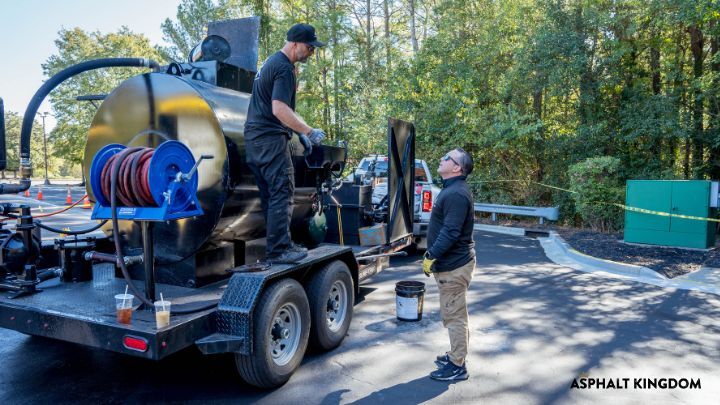Asphalt crack repair isn't just about filling cracks—it's about extending pavement life, preventing costly replacements, and doing the job right the first time. Whether you're a contractor, property manager, or DIYer, understanding the fundamentals is key to long-lasting, professional results.
Here are the four golden rules of asphalt crack repair that every pavement professional should follow—plus when to upgrade to mastics for more serious damage.
1. Clean the Crack Thoroughly
The #1 reason crack repairs fail? Poor prep. Dirt, dust, grass, and debris inside a crack act like a barrier, preventing sealant from sticking. If the crack isn’t clean, the sealant won’t bond—it’ll peel or pull away in no time.
Pro Tip: Use a high-powered blower, wire brush, or a heat lance to ensure every crack is spotless before applying any material.
2. Make Sure the Crack is Dry
Moisture is a bond breaker. Even small amounts of water in a crack will stop hot rubber sealant from adhering properly—and when temperatures shift, water expands and cracks reopen.
Pro Tip: Always schedule crack sealing during dry weather. Use a hot-air lance to remove any residual moisture before application.
3. Check the Surface Temperature
Crack sealing doesn’t work in the cold. For effective bonding, pavement temperatures must be above 40°F and rising. If it's too cold, the material cools too fast and won’t bond correctly to the crack walls.
Pro Tip: Choose warm, dry days for your asphalt crack repair jobs to ensure proper flow and adhesion.
4. Only Seal Sound Pavement
This rule is often skipped—and it leads to early failure. If the surrounding asphalt is cracked, crumbling, or alligatored, crack sealing won’t hold. Sealant needs solid pavement to bond with.
Pro Tip: If the asphalt is too damaged, patch or replace the section before sealing. Don’t try to seal cracks in unsound pavement.
What Happens When You Skip These Rules?
-2.jpg?width=720&height=405&name=Blog%20Images%20(27)-2.jpg)
When these fundamentals are ignored, you’ll see two main types of failure:
Both outcomes waste time, money, and damage your reputation. That’s why these four golden rules are non-negotiable.
When to Use Mastics Instead of Crack Sealant
Standard hot rubber sealants are perfect for cracks from ⅛ inch up to 1.5 inches wide. They’re flexible, waterproof, and ideal for routine maintenance.
But for larger structural cracks, spalling, or voids, you need something stronger: mastics
What Are Mastics?
Mastics are engineered repair materials that combine rubberized binder with aggregate. They’re thicker, more durable, and load-bearing—perfect for areas where regular crack filler just won’t cut it.
Use mastics for:
- Spalled or broken areas
- Manhole surrounds and utility cuts
- Bridge joints
- Transverse cracks
- Depressions and low spots
- Cracks wider than 1.5 inches
Mastics create a seamless, water-resistant patch that can flex with the pavement, resist de-icing salts, and withstand heavy traffic.
But Don’t Overuse Them
Not every repair needs mastics. Always ask:
- Is the pavement beneath structurally sound?
- Will the material bond properly in this environment?
- Is a simpler solution like crack filler more appropriate?
If someone tells you mastics are a one-size-fits-all fix, get a second opinion.
Why Getting Crack Repair Right Protects Your Reputation
When a crack seal fails, it’s not just a repair issue—it’s a trust issue. Callback jobs, negative reviews, and premature pavement failure can hurt your credibility and bottom line.
If you’re in the business of long-term pavement care, your success depends on quality and consistency. Following these four golden rules and knowing when to use mastics helps you:
- Deliver professional, lasting results
- Reduce warranty work and callbacks
- Build a reputation for craftsmanship
- Increase repeat customers and referrals
Final Thoughts
Asphalt crack repair is one of the most cost-effective ways to protect pavement—but only when it’s done right.
Stick to these core principles:
- Clean thoroughly
- Dry completely
- Mind the temperature
- Seal only sound pavement
And when you’re dealing with cracks or voids too wide for standard sealant, mastics are your next-level solution.
Looking for high-performance crack fillers, mastics, or application tools? Asphalt Kingdom has you covered with expert advice and trusted products from top brands.
👉 Ready to start your next asphalt crack repair project? Shop crack repair solutions now or get in touch with our experts.
-2.jpg?width=720&height=405&name=Blog%20Images%20(26)-2.jpg)




-2.jpg)
-1.jpg)